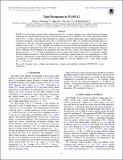Tidal Dissipation in WASP-12
Author(s)
Sung, Men; Arras, Phil; Essick, Reed Clasey; Weinberg, Nevin N.
DownloadWeinberg_2017_ApJL_849_L11.pdf (493.3Kb)
PUBLISHER_POLICY
Publisher Policy
Article is made available in accordance with the publisher's policy and may be subject to US copyright law. Please refer to the publisher's site for terms of use.
Terms of use
Metadata
Show full item recordAbstract
WASP-12 is a hot Jupiter system with an orbital period of P = 1.1 days, making it one of the shortest-period giant planets known. Recent transit timing observations by Maciejewski et al. and Patra et al. found a decreasing period with = 3.2 Myr. This has been interpreted as evidence of either orbital decay due to tidal dissipation or a long-term oscillation of the apparent period due to apsidal precession. Here, we consider the possibility that it is orbital decay. We show that the parameters of the host star are consistent with either a M ∗ ≃ 1.3 M o main sequence star or a M ∗ ≃ 1.2 M o subgiant. We find that if the star is on the main sequence, the tidal dissipation is too inefficient to explain the observed . However, if it is a subgiant, the tidal dissipation is significantly enhanced due to nonlinear wave-breaking of the dynamical tide near the star's center. The subgiant models have a tidal quality factor and an orbital decay rate that agrees well with the observed . It would also explain why the planet survived for ≃3 Gyr while the star was on the main sequence and yet is now inspiraling on a 3 Myr timescale. Although this suggests that we are witnessing the last ∼0.1% of the planet's life, the probability of such a detection is a few percent given the observed sample of ≃30 hot Jupiters in P < 3-day orbits around M ∗ > 1.2 M o hosts.
Date issued
2017-10Department
Massachusetts Institute of Technology. Department of Physics; LIGO (Observatory : Massachusetts Institute of Technology); MIT Kavli Institute for Astrophysics and Space ResearchJournal
Astrophysical Journal. Letters
Publisher
American Astronomical Society
Citation
Weinberg, Nevin N. et al. “Tidal Dissipation in WASP-12.” The Astrophysical Journal 849, 1 (October 2017): L11 © 2017 The American Astronomical Society
Version: Final published version
ISSN
2041-8213
2041-8205